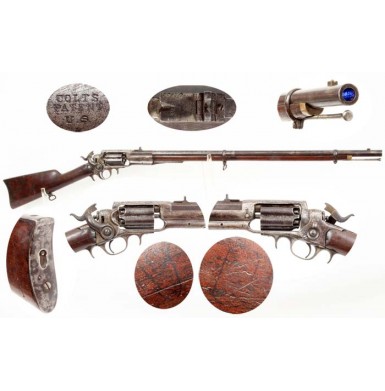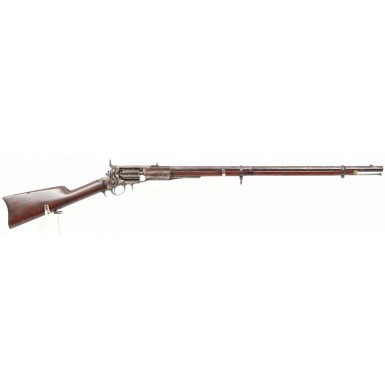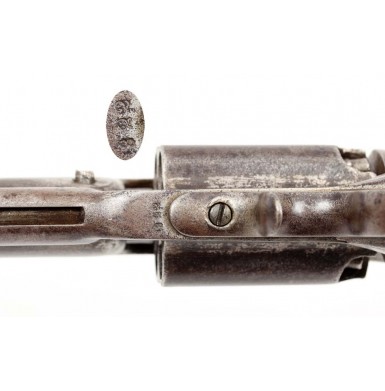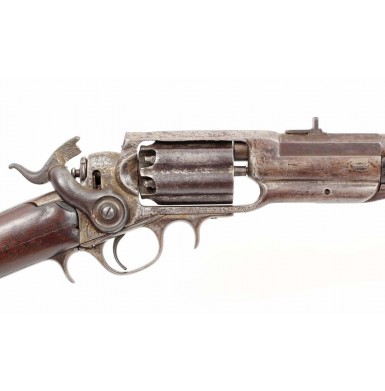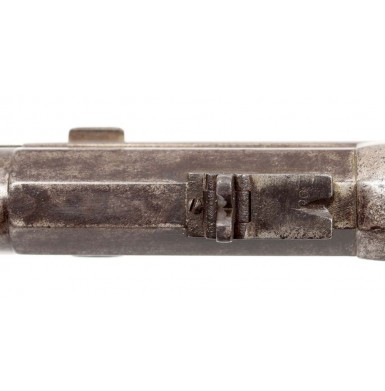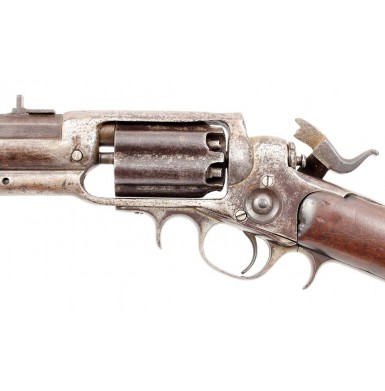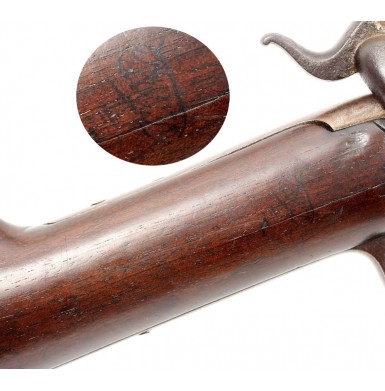Colt Revolving Military Rifle - Very Scarce .44 Variant
- Product Code: FLA-3040-SOLD
- Availability: Out Of Stock
-
$1.00
In 1855 Samuel Colt introduced his “Sidehammer” series of handguns and longarms. The handguns are known to collectors today as the “Root” revolvers, in honor of their designer, Elisha K. Root, while the revolving longarms are more generically referred to as Colt revolving rifles, carbines, or shotguns. Between 1855 and 1864 Colt produced a total of 18,300 revolving long arms, of which only 1,100 were shotguns, with the balance being rifled arms. The rifled arms were available in a wide variety of calibers from .36 through .64 and were produced as Sporting Rifles, Carbines, and Military Rifles. Depending upon the caliber and the model, the barrel lengths varied from as short as 18” for carbines and as long as 37 ““ for the larger caliber Military Rifles. The smaller caliber arms (.36, .40 & .44) were manufactured on a medium sized frame with 6 shot cylinders and larger caliber arms (.50, .56/.58 & .64) were produced on a much larger frame with 5 shot cylinders, as were the shotguns. All of the arms featured the closed top, solid frame Root design with a side mounted hammer and a cylinder pin that entered through the rear of the frame. Most of the guns had a creeping loading lever mounted under the barrel, forward of the cylinder. While the early production sporting arms had round cylinders with a roll engraved hunter and deer scene, the majority of the revolving long arms were produced with fluted cylinders. As with all of his firearms, Colt looked to the US military to as a potential customer for them and as a means of promotion for his designs. Colt felt that there was no better advertising fodder than to be able to say that his guns were used by the US military. The US military had placed their first order for Colt long arms in 1838 when they acquired 50 of the Colt Patterson Number 1 Ring Lever Rifles for use fighting the Seminoles in Florida. These revolving firearms must have rendered at least satisfactory service in the field, as additional orders were soon placed for M-1839 Patterson repeating carbines. On March 2, 1841 M-1839 repeating carbines were ordered by the US Ordnance Department for the US Navy. Subsequent orders included 60 for the US Dragoons on July 23, 1841, 100 for the US Navy’s Pacific Squadron in December of 1841 and another 100 for the US Navy on August 28, 1845. Colt had clearly gotten his foot in the door selling revolving rifles to the Ordnance Department, and despite any shortcomings of the revolving long arm designs, an order was soon forthcoming for his newest revolving rifle. In 1856 an order was placed for 100 of the new Colt M-1855 “Sidehammer” Revolving Rifles, with a total of 101 being delivered (1 being a sample rifle). The guns were the “military” model, with a full length forend that was secured with two screw tightened clamping barrel bands, sling swivels and three leaf military rear sight graduated to 100, 300 and 500/600 yards. The rifles had 31 5/16” long barrels and accepted an angular socket bayonet. While future military purchases of the Colt revolving rifles and carbines would be in the large .56/.58 caliber this first order was for the .44 caliber variant with a 6-shot cylinder. Interestingly, whether due to previous experiences with revolving long arms, due to a recommendation from Colt, or with an eye to carrying a spare loaded cylinder, the order specified that the guns were to be supplied with an extra cylinder for each rifle. All of the Colt M-1855 long guns were serial numbered in their own range, based upon caliber. While it has been generally reported that the US Military order for the .44 caliber guns are found under #300, that is based upon a survey of the few examples that were known to noted Colt author R.L. Wilson when he wrote The Book of Colt Firearms, where he notes the highest military .44 rifle serial number that he was aware of was #299. Wilson may have also obtained the “under 300” number from an old Bannerman catalog advertisement, which is one of the places that “gun show lore” often originates, usually with minimal basis in truth. It is, however, reasonable to believe that the 100 .44 military rifles that were delivered on January 22 of 1857 were probably all under serial number 400. During the production run of sidehammer rifles, a total of 3,200 .44 rifles were manufactured, 800 in the sporting configuration, 1,200 as carbines and 1,200 in the military rifle configuration. However, only 101 were actually acquired by the US military and so marked. These early .44 rifles are typically found without barrel or topstrap markings, and are simply marked on the tang in three lines: COLT’s / PATENT / US. They are cartouched on both sides of the stock wrist, and serial numbered on major components as is typical of Colt revolving firearms. There is not much written about the service that these early military Colt revolving rifles saw, but it is known that their initial issue was for the US military Utah Expedition in 1857-1858 to put down the Mormon Rebellion. The commander for the expedition was Colonel Albert Sidney Johnston, who led the recently formed 2nd US cavalry. Johnston’s field and company officers included a “who’s who” of future Civil War generals, including Robert E. Lee, William J. Hardee, Earl Van Dorn, Edmund Kirby Smith, Fitzhugh Lee and John Bell Hood, all of who would serve as generals in the Confederate Army during the coming war. Future Union generals George H. Thomas, George Stoneman and Kenner Garrard also served in the 2nd Cavalry’s officer corps. The orders to confront the Mormon’s were subsequently retracted and the 2nd Cavalry spent the next 2 years fighting the Comanche Indians in Texas and Kansas, with famous victories at Devil’s River, Wichita Village, Rush Springs and Crooked Creek. While the majority of the 2nd Cavalry was armed with Sharps or Hall carbines and with Colt M-1851 “Navy” revolvers, it appears that at least some of the troopers were still carrying the .44 Colt revolving rifles they had been issued prior to the beginning of the Mormon Expedition. With the coming of the American Civil War, many of the officers of the 2nd Cavalry resigned their commissions to return to their homes in the south and subsequently offer their services to the Confederate Army. It is likely that a number of troopers left the 2nd for the same reason, although the enlisted men would be considered deserters as they did not have the option to resign. As the 2nd was in the newly seceded southern state of Texas at the outbreak of the war and did not return to Carlisle Barracks to reorganize until the winter of 1861, it is generally believed that most of their arms and accouterments were taken into the service of the state of Texas. This probably accounts for the extreme scarcity of surviving Colt .44 Revolving Military Rifles; the guns simply saw hard service on the frontier and eventually saw even harder service with Texas Confederate troops during the Civil War. The most famous period image of a .44 caliber Colt Military rifle is that of US Surgeon Albert J. Myer, who was photographed with one at Fort Duncan, TX sometime in 1857. Myer later went on to establish the “wig-wag” system of signal flags, was made Signal Officer in 1860 and eventually established and ran the US Signal Corps during the American Civil War. Myer’s .44 Colt Military Revolving Rifle (serial number 33) sold at auction in 2002 for more than $30,000. It is not clear what regiments and men may have carried the .44 caliber Colt revolving military rifles during the American Civil War, as records rarely mention the caliber of the revolving rifles in service. The majority of those guns, however were certainly the .56/.58 musket caliber examples that were purchased in much larger quantities with the coming of the Civil War.
Offered here is a scarce and rarely encountered Colt .44 US Military Revolving Rifle. The gun is in about GOOD+ condition, and like most Colt revolving rifles that saw US military service, it shows hard use. The gun shows minimal markings, which is correct for the early production, low serial number, military acquired arms. The top strap is unmarked, which is typical on these guns, according to Wilson, and the frame is unmarked as well. The tang is correctly marked in three lines: COLT’s / PATENT / U.S.. The serial number 322 is stamped on the bottom of the frame, on the bottom of the barrel (under the forend), on the triggerguard tang and on the cylinder pin. No serial number is visible on the rear of the cylinder. This may be due to wear and flash pitting or it may be that this is one of the replacement cylinders that were delivered with the rifles in 1857. Under strong magnification the trace of the patent date marking are barely visible in one of the cylinder flutes, but for all practical purposes, it has been obliterated by wear. The buttstock is marked with US military inspection cartouches on both wrists, with the obverse cartouche being a fairly legible script WAT for accepting US Ordnance Officer William Anderson Thornton. The reverse cartouche is quite weak and cannot be deciphered, but is that of the arsenal sub-inspector who initially passed the gun for military service. As noted, the gun is in about GOOD+ overall condition. The rifle is basically functional, and when the hammer is cocked the cylinder rotates as it should and the hammer locks securely into both the half cock and full cock positions. Pulling the trigger releases the hammer as it should, but the cylinder does not remain locked in place and counter rotates about half a turn as the hammer falls. This mechanical issue is probably due to a weak cylinder stop spring or poor engagement (or wear) between the cylinder and the arbor pin. Timing and indexing issues are common with “Root” sidehammer handguns and long guns, and were one of the downfalls of the design. Wear between the cylinder pin and cylinder was common and created malfunctions. A competent gunsmith could probably rectify the problem with a minimum of trouble. The creeping loading lever functions correctly and remains quite tight, requiring some effort to release the retention catch and operate the lever. The release button for the arbor pin appears to be an old replacement that is not original to the rifle, but has a patina that matches the gun suggesting it has been there for a very long time. A couple of the frame screws appear to be more recent replacements as well. The gun has a mottled gray and plum brown patina that suggests the gun was cleaned a long time ago, and has since had many years to tone down. The cylinder has a more even plum brown patina, but may have simply been harder to clean and was thus spared. The cylinder patina matches the patina on the rear of the frame perfectly, as well as the darker patches on the barrel. The frame shows light to moderate pitting overall, with the deepest and most significant pitting being on the topstrap and forward of the cylinder. This is to be expected, as the revolving rifles were notorious for spraying lead and caustic gases from the cylinder to barrel gap when the gun was fired. This is why these rifles were equipped with a dual spur triggerguard; the forward spur was intended to provide a grip point between the spur and triggerguard for the left hand. Placing the left hand forward of the cylinder was certain to result in injuries from burning powder and molten lead that would escape from the cylinder gap. Sometimes the escaping gas and lead ended up in more irritating places than the hand and arm, as one Colt representative opined in a letter to the Colonel on January 29, 1860 from Milledgeville, GA “I could sell a great number of the shot guns if I had the proper confidence in them”..Took me all the evening to pick the powder and pieces of lead out of my face. No use telling a person to hold their head back, might as well tell them to hold it under their arm.” The cylinder also shows lightly scattered pitting and some scaly surface oxidation. The original cones (nipples) are all in place at the rear of the cylinder, and they are in about very good condition, showing the expected use, and corrosive wear from the fulminate of mercury percussion caps. The barrel is much smoother than the frame and has a more consistent patina. However, it still shows a blotchy gray and plum brown coloration. The metal is mostly smooth with only some scattered light pitting and some scattered pinpricking present. The bore rates NEAR VERY GOOD and is dark and dirty with strong rifling present. A good scrubbing would probably improve the bore. The bore appears to have light to moderate pitting its entire length. The original front sight and bayonet mounting stud is present on the top of the barrel near the muzzle. The gun is designed to accept an “Enfield” style socket bayonet, which Colt no doubt imported from his English contacts and suppliers. The bridge of a US M-1855 socket bayonet will not clear front sight to mount on the rifle. The original rear sight is dovetailed into the small octagon portion of the barrel, forward of the cylinder. The sight retains its original fixed 100-yard leaf and the folding 300-yard leaf but the long-range leaf (either 500 or 600 yards) is missing. Interestingly Surgeon Myer’s rifle was missing that sight leaf when it was sold 13 years ago. I cannot find a high enough resolution picture of Myer with his rifle to determine if his sight leaf was missing when that image was struck. Both original barrel bands are in place on the rifle, but the upper sling swivel may be a replacement. The upper barrel band tension screw appears to be a replacement. The original brass forend cap is in place at the end of the forestock. The original rear sling swivel is in place in the toe of the stock. A full length cleaning rod is in place in the channel under the barrel, and it appears to be a period made replacement for this gun. The rod is full length and threaded on the end, but the shape of the “rammer” end is not correct for a Colt rifle, and the rod shows a typical blacksmith style angled hammer weld joining the tip of the rod to the body of the rod. The rod is definitely of the period and has probably been with the rifle since the late 1850s or early 1860s, but is not the factory original rod. The original butt trap remains in the buttstock for the storage of the cleaning jag, but it is not present. The stock and forend of the rifle rate NEAR VERY GOOD. They both show the wear you would expect of a 19th century military rifle that saw service in the west and probably during the Civil War. The buttstock appears to have been cleaned long ago, and the buttstock probably splintered some around the tang. This area is now very smooth and shows some minor gapping; suggesting the area around the tang was sanded lightly to clean the wood up after some minor damage in that area. There is also a short surface grain crack running down the middle of the right side of the wrist. This does not appear to be structural, and remains tight and solid. The wrist area of the rifle has the appearance of a banister polished by thousands of hands over the years, while the rest of the buttstock does not have that same polished appearance. The rifle was clearly handled and used a lot, with the wrist area developing that polished look from use. The balance of the buttstock just shows the bumps, dings and mars that would be expected from a mid-19th century military arm. As noted above a faint cartouche is present on the reverse of the stock and a decent cartouche is present on the obverse. The forend shows the same wear and mars noted on the butt, with a few more significant ding and bruises. The forends of Colt revolving rifles are notoriously thin and are prone to splinter and crack. This one appears to be solid and essentially free of any serious external cracking, but does show splintering along the cleaning rod channel. As with every other Colt rifle I have had, the forend has shrunk some, and the screw clamping barrel bands do not tighten quite enough to keep from moving along the stock from time to time. This is a common problem with P.S. Justice muskets as well (notorious for being made with poorly seasoned stocks), and may indicate Colt did not adequately season the wood for his forends. Other than the noted wear and tear both the butt and forend remain solid and complete. Neither the butt nor the forend bears a visible serial number when removed, but these numbers were usually written in ink or pencil and are prone to wear and fading over time.
Overall this is a good, solid example of what R.L. Wilson refers to as the “rarest of Hartford contract arms”. With only 101 of these rifles being delivered to the US military, including the sample, they are incredibly scarce today. Only a handful of the US inspected .44 Colt Military Revolving Rifles are known to exist today and at least a couple of them are in institutional collections. When this gun was found and first collected a very old, possibly buffalo hide, sling accompanied it, and the sling was held around one of the swivels with some old iron tacks. The sling will be included with rifle. It is my understanding that this gun has probably not been on the market since the 1950s or 60s and truly a fresh specimen for an advanced Colt collector. While the overall condition of the gun does leave a little to be desired, most of the issues appear to be from heavy use and honest wear. This gun almost certainly served with the 2nd US Cavalry fighting the Comanche Indians in the west, and may well have been handled or used by some of the famous Civil War generals who served in that unit prior to the Civil War. I know of only one other military inspected .44 caliber Colt Revolving rifle to be offered for sale over the last decade, so you may not have another chance to add one of these to your collection any time soon. This is a very scarce and important US military Colt revolving rifle and certainly a gun missing from even the most advanced Colt collections.
SOLDTags: Colt, Revolving, Military, Rifle, Very, Scarce, 44, Variant

